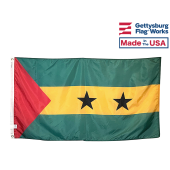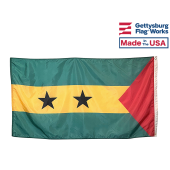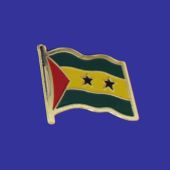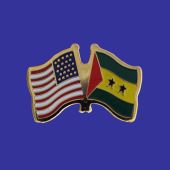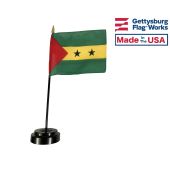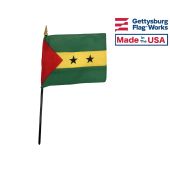Buy Sao Tome and Principe Flags
Flag of Sao Tome and Principe
The flag of Sao Tome and Principe is a symbol of both the nation itself and the history of its independence movement. That flag is derived from that of the political party that led the push for the nation's independence from Portugal at the end of the colonial era. It shows only the faintest hint of influence from the previous Sao Tome and Principe flag that was used during the country's time as a colony, so it embodies the nation's clean break from its past as part of a European empire.
- Capital of Sao Tome and Principe: Sao Tome
- Area of Sao Tome and Principe: 1,001 sq. km
- Languages used in Sao Tome and Principe: Portuguese (official)
- Religions in Sao Tome and Principe: Catholic, Evangelical, New Apostolic, Adventist
Colors and Symbolism of the Sao Tome and Principe Flag
The Sao Tome and Principe flag is made up of three horizontal stripes that alternate between green and yellow that stretch out from a red triangle that is aligned along the flag's hoist. Two black stars with five points are placed in the yellow stripe. Those two stars represent the country's two islands. The flag's colors also give symbolic meaning to the flag of Sao Tome and Principe. The green stripes represents the nation's plant life, while the yellow stripe represents the sun and the cocoa industry that makes up a large part of the nation's economy. The red triangle is a symbol of both equality and the nation's struggle for independence from the Portuguese Empire. The three colors are also associated with the Pan-African movement, which indicates solidarity with the other nations of Africa.
History of the Flag of Sao Tome and Principe
The first flag of Sao Tome and Principe was the flag of Portugal, which began to represent the islands when they were brought under the control of Portugal in the 16th century. The islands used the flag of Portugal for four centuries before the Movement for the Liberation of Sao Tome and Principe formed and began to use a precursor to the modern flag. Their flag followed the same pattern as the existing flag, but it was displayed in different proportions. The country adopted its first national flag in 1975, and chose to base the design for its flag on that of the independence movement in order to show the movement's importance for the nation's history and the politics of the day. The flag was retained when the movement's leaders left power in 1990, which means that the flag has represented the nation for all of its time as an independent nation without undergoing any changes.
